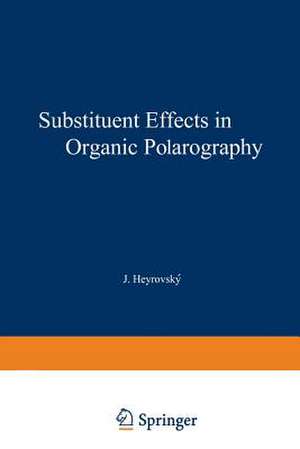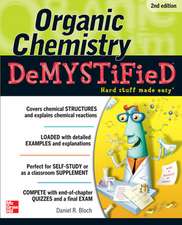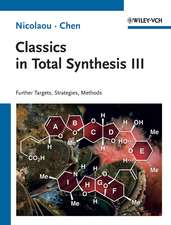Substituent Effects in Organic Polarography
Autor Petr Zumanen Limba Engleză Paperback – 6 mai 2012
Preț: 393.35 lei
Nou
Puncte Express: 590
Preț estimativ în valută:
75.27€ • 78.80$ • 62.28£
75.27€ • 78.80$ • 62.28£
Carte tipărită la comandă
Livrare economică 05-19 aprilie
Preluare comenzi: 021 569.72.76
Specificații
ISBN-13: 9781468486636
ISBN-10: 1468486632
Pagini: 404
Ilustrații: XVI, 384 p.
Dimensiuni: 152 x 229 x 21 mm
Greutate: 0.54 kg
Ediția:1967
Editura: Springer Us
Colecția Springer
Locul publicării:New York, NY, United States
ISBN-10: 1468486632
Pagini: 404
Ilustrații: XVI, 384 p.
Dimensiuni: 152 x 229 x 21 mm
Greutate: 0.54 kg
Ediția:1967
Editura: Springer Us
Colecția Springer
Locul publicării:New York, NY, United States
Public țintă
ResearchCuprins
I Introduction.- 1. Development of the Study of Structural Relations.- 2. Classification of Structural Effects.- 3. Techniques in the Polarographic Study of Structural Effects.- II General Equation for the Relation Between the Polarographic Half-Wave Potentials and Substituent Effects.- 1. General.- 2. Influence of Polar Effects.- 3. Influence of Polar and Resonance Effects in Combination.- 4. Influence of Polar and Steric Effects in Combination.- 5. The General Case.- 6. The Role and Importance of the General Equation.- 7. The Conditions for the Application of the General Equation.- III Benzene Derivatives.- 1. General.- 2. Selection of Values of the Substituent Constants.- 3. Selection and Treatment of Half-Wave Potential Values.- 4. Reaction Series for which Equations (27), (31), and (37) Hold.- 5. Range of Validity of Equation (27); Significance of Deviations for the Discussion of Electrode Process Mechanism.- 6. Additivity of Substituent Effects.- 7. Application of the Constants ?X? and the Determination of New Values of the Substituent Constants ?X.- 8. Ortho Derivatives—Application of Equation (37).- 9. Hindrance of Coplanarity due to Ortho Substituents.- 10. The Question of Hydrogen Bonds in Ortho-Substituted Compounds.- 11. Factors Affecting the Reaction Constant ??,R.- 12. Other Empirical Relationships.- 13. Applications of (27) and Related Equations.- IV Monocyclic Heterocyclic Compounds.- 1. General.- 2. Classification of Reaction Series.- 3. Reducible Heterocyclic Rings.- 4. Reduction in the Side Chain.- V Reaction Series in which the Electroactive Group is Directly Attached to an Alkyl or Aryl Substituent.- 1. General.- 2. Reactions for which Equations (25), (29), and (36) Hold.- 3. Effect of Changes in the Mechanism of the Electrode ProcessReflected in Deviations from Linear Free Energy Relations and Changes in the Sign of the Reaction Constant.- 4. Effect of Exchange of Methyl for Phenyl.- 5. Effect of Transfer Coefficient..- 6. Additivity of Substituent Effects.- 7. Factors Affecting the Value of the Reaction Constant ??,R*.- 8. Application of Equations (25) and (29) for the Determination of New Values of the Substituent Constants ?XI and ?X*.- 9. Other Empirical Quantitative Relations.- 10. Two Functional Groupings in a Molecule.- VI Effects of Substituents in Condensed Polycyclic Hydrocarbons.- 1. General.- 2. Classification of Reaction Series.- 3. Electroactive Aromatic System with One Substituent.- 4. Polysubstituted Electroactive Aromatic Systems.- 5. Effects of a Substituent in a Condensed Aromatic Hydrocarbon on the Reduction of a Functional Grouping in Another Position in the Ring System.- 6. Effect of the Nature of the Aromatic Ring on Reduction in the Side-Chain.- 7. Substituent in a Reducible Side-Chain.- VII Effects of Substituents in Polycyclic Heterocyclic Compounds.- 1. General.- 2. Classification of Reaction Series.- 3. Effect of a Substituent in an Electroactive Heterocyclic Ring.- 4. Effect of Substituents in the Benzene Ring and in Both Rings on the Reduction of the Heterocyclic Ring.- 5. Effect of Substitution in a Phenyl Group Attached to Electroactive Heterocyclic Ring.- 6. Correlation of the Reactivities of Various Heterocyclic Compounds by the Use of Dimroth Equation.- 7. Effect of Substitution in the Heterocyclic Ring on Reduction in a Side-Chain on the Same Ring.- 8. Effect of Substitution in the Benzene Ring on Reduction in a Side-Chain on the Heterocyclic Ring.- 9. Effect of the Position and Nature of the Heterocyclic Ring on Reduction in the Side-Chain.- VIII Effects ofSubstituents in Quinonoid Compounds.- 1. General.- 2. Classification of Reaction Series.- 3. Monocyclic Quinonoid Systems.- 4. Bicyclic Quinonoid Systems.- 5. Polycyclic Quinonoid Systems.- IX Alicyclic Systems.- 1. Effects of Substituents in the Ring on an Electroactive Group Attached to the Ring.- 2. Effect of Ring Size and Type on an Electroactive Group Attached to the Ring.- 3. Effect of Ring Size and Type on Electroactive Groups that Form Part of the Cyclic System.- 4. Conclusions.- Author Index.









